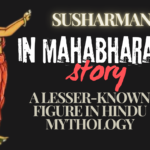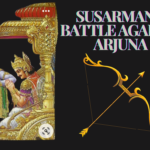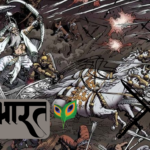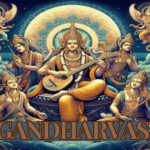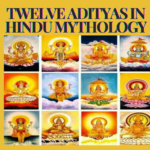The Mahabharata War, also known as the Kurukshetra War, stands as one of the most significant battles in ancient Indian history. This war, fought between the Pandavas and the Kauravas, involved numerous mighty warriors, many of whom perished in the fierce conflict. However, some warriors survived the 18-day-long war and went on to play pivotal roles in the post-war scenario. In this article, we delve deep into the lives and legacies of the 18 warriors who survived the Mahabharata War, highlighting their valor, their contributions, and their fates after the war.
1. Yudhishthira: The Eldest of the Pandavas.
Yudhishthira, the eldest of the Pandavas, was renowned for his unwavering commitment to dharma (righteousness). Despite witnessing the brutalities of war, Yudhishthira maintained his integrity and fairness throughout. After the war, he ascended to the throne of Hastinapura and ruled with wisdom and justice. His reign was marked by peace and prosperity, and he is remembered as a king who upheld truth and righteousness above all else.
2. Bhima: The Mighty Warrior.
Bhima, known for his incredible strength and fearsome prowess in battle, played a key role in the defeat of the Kauravas. He was responsible for slaying many prominent warriors, including Duryodhana, the eldest of the Kauravas, and the formidable Dushasana. Bhima survived the war and continued to serve his brother Yudhishthira. His strength and valor were instrumental in maintaining the security and stability of the kingdom.
3. Arjuna: The Master Archer.
Arjuna, the finest archer of his time, was a pivotal figure in the Pandava army. Guided by Lord Krishna, his charioteer, and philosopher, Arjuna fought valiantly against many of the greatest warriors of the Kaurava side, including Karna, Bhishma, and Drona. Arjuna survived the war and continued his journey, dedicating himself to the service of dharma and his kingdom. He later played a significant role in spreading the message of the Bhagavad Gita, which Krishna had imparted to him on the battlefield.
4. Nakula: The Handsome Twin.
Nakula, the fourth of the Pandavas, was known for his exceptional skills with the sword and his expertise in horse-riding. Though less prominent in the battle’s major confrontations, Nakula played an essential role in the Pandava’s war strategies. After the war, he served Yudhishthira faithfully and helped in the administration of the newly unified kingdom.
5. Sahadeva: The Wise Twin.
Sahadeva, the youngest of the Pandavas, was celebrated for his wisdom and intelligence. A skilled swordsman like his twin brother Nakula, Sahadeva also had profound knowledge of astrology and medicine. After the war, he remained a trusted advisor to Yudhishthira and contributed significantly to the governance and welfare of the kingdom.
6. Krishna: The Divine Guide..
Lord Krishna, the charioteer and guide of Arjuna, was instrumental in shaping the course of the Mahabharata War. He provided the Pandavas with strategic insights and divine intervention when needed. After the war, Krishna returned to Dwaraka, where he continued to rule until his departure from the mortal world, marking the beginning of the Kali Yuga.
7. Satyaki: The Vrishni Warrior.
Satyaki, a warrior of the Vrishni clan and a disciple of Arjuna, fought bravely on the Pandava side. Known for his loyalty and valor, Satyaki played a crucial role in protecting Yudhishthira and other Pandava leaders. After the war, he returned to Dwaraka, where he continued to serve Krishna until his death during the internal conflicts that led to the downfall of the Yadava dynasty.
8. Kritavarma: The Yadava Warrior.
Kritavarma was another warrior from the Yadava clan who fought for the Kauravas. A brave and skilled fighter, he survived the war but met his end in the aftermath of the war during a violent brawl among the Yadavas. His death was part of the tragic end of the Yadava dynasty, which marked the final phase of the Dwapara Yuga.
9. Ashwatthama: The Son of Dronacharya.
Ashwatthama, the son of Guru Dronacharya, was one of the most feared warriors on the Kaurava side. Though he survived the war, he faced severe consequences for his actions. After using the deadly Brahmastra weapon against the Pandavas, he was cursed by Lord Krishna to wander the earth for eternity, suffering from incurable wounds. His fate remains one of the most tragic tales in the aftermath of the Mahabharata War.
10. Kripacharya: The Royal Preceptor.
Kripacharya, the royal preceptor of the Kauravas and Pandavas, was known for his mastery in archery and his steadfastness in battle. He survived the war and later took on the role of a spiritual guide and mentor to the surviving members of the Kuru dynasty. His wisdom and knowledge were invaluable in restoring order and stability in the kingdom after the war.
11. Yuyutsu: The Kaurava Who Switched Sides.
Yuyutsu, a lesser-known son of Dhritarashtra, chose to fight for the Pandavas, recognizing the injustice of Duryodhana’s actions. He was one of the few Kauravas who survived the war. After the war, Yuyutsu played a critical role in the administration of Hastinapura, supporting Yudhishthira in his efforts to rule justly.
12. Vidura: The Wise Counselor.
Though not directly involved in the battlefield combat, Vidura, the wise counselor and half-brother to Dhritarashtra and Pandu, survived the war. His wisdom and insight were invaluable during the war and its aftermath. Vidura continued to play a significant role in the governance of Hastinapura until his death.
13. Sanjaya: The Narrator of the War.
Sanjaya, the charioteer and advisor to Dhritarashtra, played a unique role as the narrator of the war. Through his divine vision, he was able to recount the events of the war to the blind king. Sanjaya survived the war and remained in the service of the royal family, continuing to provide counsel to the king.
14. Uddhava: The Disciple of Krishna.
Uddhava, a close disciple and friend of Krishna, survived the war and continued to spread Krishna’s teachings. His deep understanding of spiritual knowledge made him a significant figure in the aftermath of the war, as he shared Krishna’s messages with the people.
15. Dhritarashtra: The Blind King.
Dhritarashtra, the blind king of Hastinapura, survived the war but was left devastated by the loss of his sons and the destruction of his lineage. After the war, he continued to live in Hastinapura under the care of Yudhishthira and later retired to the forest with his wife, Gandhari, where he spent the rest of his days in penance..
16. Gandhari: The Grieving Mother.
Gandhari, the queen of Hastinapura and the mother of the Kauravas, survived the war but was heartbroken over the death of her sons. She cursed Krishna for the destruction of her family, which ultimately led to the downfall of the Yadavas. After the war, she retired to the forest with her husband, Dhritarashtra, and spent the rest of her life in austerity.
17. Kunti: The Mother of the Pandavas.
Kunti, the mother of the Pandavas, lived through the war and its aftermath. She remained in Hastinapura, supporting her sons as they took over the reins of the kingdom. She later accompanied Dhritarashtra and Gandhari to the forest, where she embraced a life of simplicity and penance.
18. Uttara: The Widow of Abhimanyu.
Uttara, the widow of Abhimanyu (Arjuna’s son), survived the war, carrying Abhimanyu’s posthumous son, Parikshit, who was the only surviving heir to the Pandava dynasty. After the war, Uttara played a crucial role in raising Parikshit, who later became the king of Hastinapura, ensuring the continuation of the Pandava lineage.
The Mahabharata War was a period of immense turmoil and tragedy, yet it also set the stage for renewal and growth in ancient India. The warriors who survived this epic conflict went on to shape the future of their kingdoms in various ways, leaving an indelible mark on history. These 18 warriors symbolize resilience, duty, and the pursuit of righteousness, each playing their part in the aftermath of one of the greatest wars ever fought.
